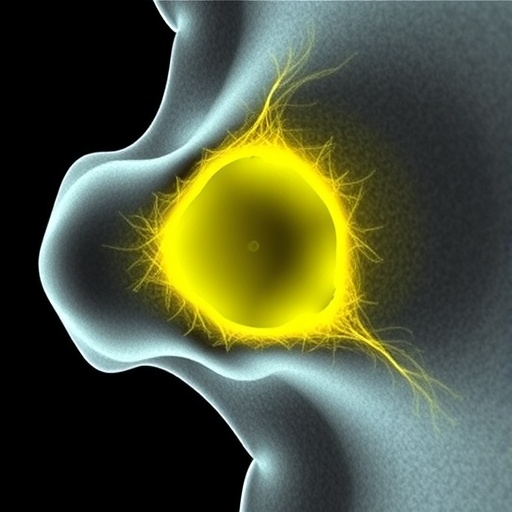In the microscopic world of bacteria, survival often hinges on the ability to adapt rapidly to changes in the environment, particularly stressors that threaten their structural integrity. A groundbreaking study published in Nature Microbiology unveils a sophisticated molecular mechanism by which Bacillus subtilis and related Gram-positive bacteria regulate their internal pressure to withstand defects in their protective cell wall. The key player in this biological drama is cyclic-di-AMP (c-di-AMP), an essential second messenger that has emerged as a pivotal regulator of cellular turgor, the hydrostatic pressure within bacterial cells that balances against the rigidity of the cell wall.
For over a decade, scientists have recognized c-di-AMP as a crucial signaling molecule influencing ion transport and osmoregulation, shaping the landscape of bacterial physiology. However, the upstream triggers modulating c-di-AMP levels remained an enigma until the recent work by Brogan, Bardetti, Rojas, and colleagues shed light on the signals that govern this elusive second messenger. Their research reveals that when the cell wall of Bacillus subtilis is compromised, a sophisticated sensor protein, termed CdaR, detects these defects and orchestrates a dynamic increase in c-di-AMP production. This surge acts as a molecular switch, altering cellular turgor to prevent catastrophic cell lysis while promoting the reinforcement of the cell wall.
This discovery is remarkable because it links structural failure cues directly to biochemical signaling pathways, providing a direct feedback mechanism that maintains cellular homeostasis. The bacterial cell wall, composed primarily of peptidoglycan, serves as a robust but flexible exoskeleton, crucial for maintaining shape and protecting against environmental stress. If this structure is weakened, without adequate compensation, the cell risks bursting due to the high internal pressure exerted by its cytoplasm. Thus, fine-tuning turgor pressure is vital, and c-di-AMP appears to be the molecular fulcrum regulating this balance.
To understand the significance of this regulatory circuit, it’s essential to explore how c-di-AMP operates as a second messenger. Unlike common nucleotides like ATP, second messengers transmit specific intracellular signals rapidly and reversibly. In Gram-positive bacteria, c-di-AMP controls the activity of specialized transporters that modulate the uptake and efflux of cations and compatible solutes—molecules that influence osmotic balance. Through this control, bacteria can adjust their internal ionic strength and volume, effectively modulating turgor pressure.
The novel insight from the study is the identification of CdaR as a cyclase regulator that senses cell wall integrity. CdaR is intricately associated with the enzyme machinery synthesizing c-di-AMP. When structural defects arise, CdaR activates the diadenylate cyclase to ramp up c-di-AMP synthesis. The elevated levels of this cyclic dinucleotide reduce turgor pressure by tuning transporter function, thereby preventing the cell from succumbing to osmotic shock and lysis.
This feedback mechanism represents a critical survival strategy for bacteria, especially in fluctuating environments where cell wall stress can be induced by antibiotics, immune system attacks, or natural environmental challenges. By modulating turgor, bacteria not only avoid rupture but also gain time to reinforce their peptidoglycan meshwork. This fortification improves mechanical strength and restores cellular integrity, highlighting an elegant cross-talk between cell wall maintenance and osmotic regulation.
The implications of these findings extend beyond basic bacterial physiology into the realm of antimicrobial development. Understanding how bacteria sense and respond to cell wall damage offers new therapeutic targets. Drugs that interfere with c-di-AMP signaling, or the function of CdaR, might destabilize bacterial turgor regulation, rendering pathogens more vulnerable to lysis. Such an approach could potentiate existing antibiotics or inspire novel treatment strategies against resistant Gram-positive infections.
Moreover, the study opens new avenues in bacterial signal transduction research. Identifying the molecular details of CdaR’s sensing mechanism and its interactions with the cyclase could yield insights into the design principles of bacterial stress responses. Additionally, the broader family of bacterial second messengers, including c-di-GMP and cAMP, are known to orchestrate diverse behaviors from biofilm formation to motility. Unraveling how c-di-AMP integrates into these signaling networks could reveal sophisticated layers of control coordinating bacterial physiology.
From a methodological perspective, the research utilized a combination of genetic, biochemical, and biophysical techniques to dissect this regulatory pathway. Advanced imaging and reporter assays demonstrated changes in turgor pressure correlating with c-di-AMP levels, while mutant strains lacking functional CdaR exhibited heightened sensitivity to cell wall stress. These comprehensive analyses underscore the robustness of the regulatory model proposed by the authors.
Furthermore, the discovery emphasizes the evolutionary ingenuity of bacteria. Despite their seeming simplicity, these organisms have evolved highly sensitive molecular circuits to monitor and adjust their physical state, ensuring survival under adverse conditions. The cross-regulation between cell wall integrity and cytoplasmic pressure exemplifies such adaptive sophistication.
In conclusion, Brogan and colleagues’ work unravels a fundamental aspect of bacterial physiology by linking a key second messenger, cyclic-di-AMP, with the control of cellular turgor through a sensor of cell wall damage. This newly characterized signaling axis enables bacteria to fine-tune internal pressure to prevent lysis and enhance their cell wall robustness, offering exciting insights with far-reaching implications for microbiology and infectious disease therapeutics. As research on bacterial second messengers advances, the prospect of targeting such finely balanced regulatory systems promises to transform our approach to combating bacterial pathogens.
Subject of Research: Regulation of cellular turgor pressure by cyclic-di-AMP in response to bacterial cell wall defects.
Article Title: Cyclic-di-AMP modulates cellular turgor in response to defects in bacterial cell wall synthesis.
Article References:
Brogan, A.P., Bardetti, P., Rojas, E.R. et al. Cyclic-di-AMP modulates cellular turgor in response to defects in bacterial cell wall synthesis. Nat Microbiol (2025). https://doi.org/10.1038/s41564-025-02027-2
Image Credits: AI Generated




